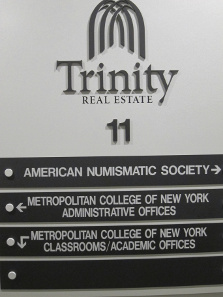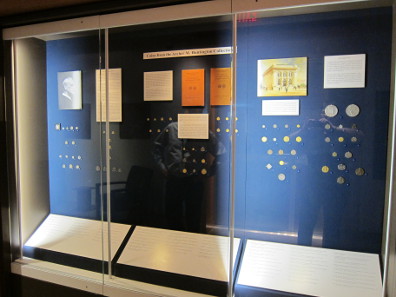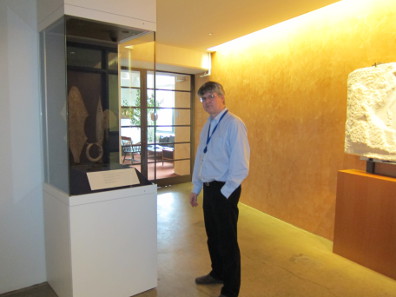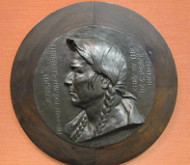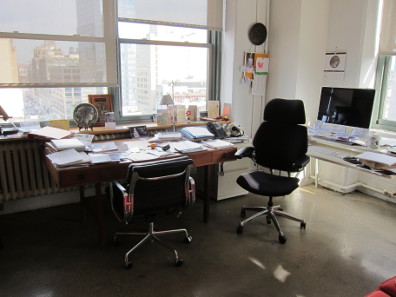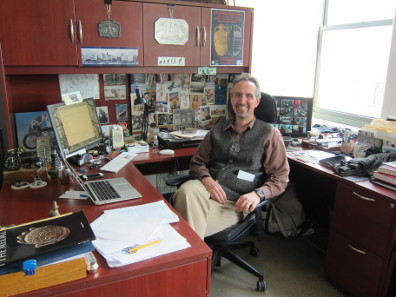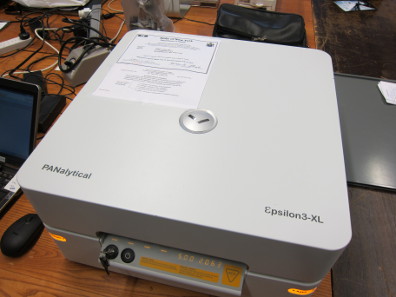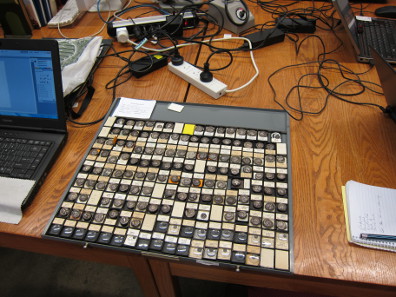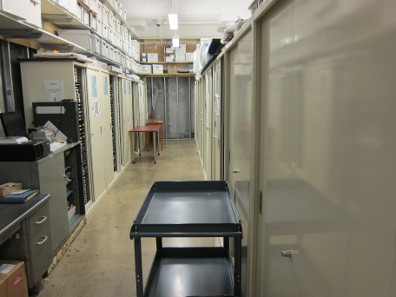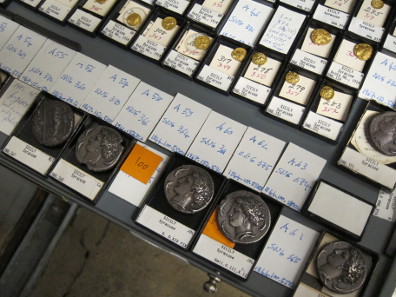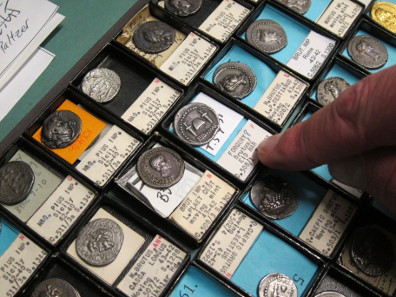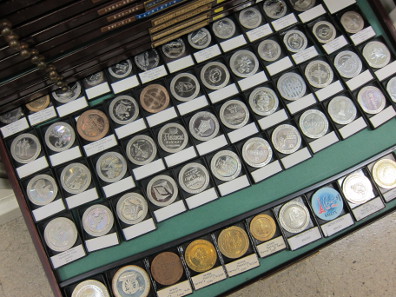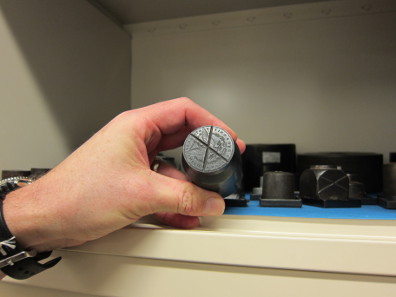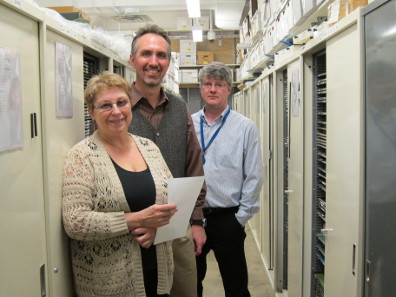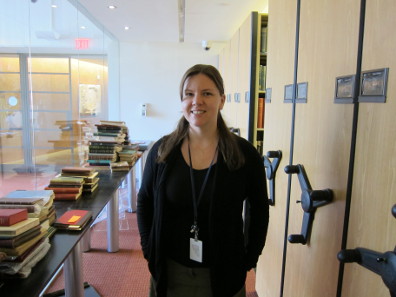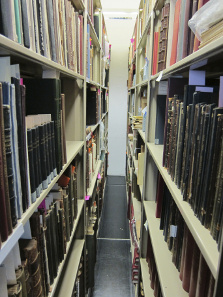by Ursula Kampmann
translated by Teresa Teklic
January 30, 2014 – Parva ne Pereant – so the small may not perish! I cannot conceive of a better motto for a society that is exclusively devoted to preserving the smallest historical objects there are, to coins and other numismatic artifacts. The American Numismatic Society has taken this motto to heart and has been conducting research on numismatics and the history of economics for over 150 years.
If you want to visit the ANS these days, you need to go to Lower Manhattan, to New York’s Financial District, where the society has been headquartered since 2008. By the looks from the outside, you almost would not recognise 75 Varick St as the headquarters. A new museum will soon be opening on the ground floor – and, mind you, not a museum about coins, but one about Jackie Robinson, a famous black American baseball player.
The 11th floor is shared by the ANS and the Metropolitan College of New York. Photo: UK.
The entrance of the building is to the right of the museum. Despite the somewhat misleading inscription “One Hudson Square”, which does not correspond to the official address, this is the place that hosts the sacred halls of the ANS on the 11th floor. In order to receive the required visitor’s pass, you need to identify yourself. However, this is the only requirement. Apart from that, everybody is usually granted access. After checking in, members of the ANS are allowed to frequent the collection as often as they want; non-members may do so as well, but will have to pay a daily fee of $10. Students have free entry, independent of their status as member or non-member. The same conditions apply to the enormous library, the archive and the lectures regularly hosted by the ANS.
The show cases regularly exhibit smaller exhibitions. Photo: UK.
Admission to the exhibitions, on the other hand, is free. In the ANS foyer, there are a number of show cases which often display newly acquired objects. At the moment, they show a part of Vladimir and Elvira Clain-Stefanelli’s archive as well as selected items from the Huntington Collection. CoinsWeekly also reported in detail about what happened to the Huntington Collection: the collection, which had been on permanent loan at the ANS nearly ever since its foundation, had been auctioned off by its owner, the Hispanic Society of America, due to financial difficulties. With the help of generous donors, however, the ANS succeeded in buying back a large part of the collection.
Andrew Meadows shows us one of the most recent additions: Alan Helms donated a collection of African iron money to the ANS in 2012. Photo: UK.
Speaking of which – the importance of sponsors simply cannot be stressed enough! Without their help the ANS could not achieve nearly as much as it does. Unlike many other museums and research institutes, the society is barely subsidised by the government. Wages, publications, projects and other various expenses have to be covered by third-party funds. Fortunately, the responsible curators have truly mastered this discipline. Most European museums would be amazed by the highly sophisticated strategies for addressing different target groups. Donations of important collections are nothing out of the ordinary. Currently, one of the show cases displays Alan Helms’ collection of African iron money which he gave away to the ANS in 2012.
The conference room. Photo: UK.
The conference room is located next to the foyer. It hosts regular talks as well as the famous Summer Seminar which brings together selected students every year. The event addresses not only numismatists but also students of history, art history or archaeology who are not given a numismatic training at their home university. During a two-week long course they receive a thorough training in dating and using coins.
Plaque depicting Chief Joseph. Photo: UK.
The conference room is decorated with impressive paintings and plaques, for instance with the huge bronze plaque from 1889 of Olin Levi Warner, who served as model for a medal of the famous Indian Chief Joseph. Chief Joseph belonged to the tribe of the Nez Perce. His skill in warfare and the way he and his men fought the American troops was much admired even by his enemies and won him the byname “red Napoleon”. The artist’s wife donated this object to the ANS in 1921.
The office of Ute Wartenberg Kagan, Executive Director of the ANS. Photo: UK.
Behind the area which is accessible to the public, the offices of the administration and the numismatists are situated. This is Ute Wartenberg Kagan’s office. She originates from Germany and studied in Saarbrücken and Oxford. She has held the position of Executive Director since 1999 and strongly influenced the ANS’s change from a purely academic society to an institution which addresses the broader public. One project that shows her attitude is a cooperation with the Federal Reserve Bank of New York producing the exhibition “Drachmas, Doubloons and Dollars: The History of Money“ that was opened by Alan Greenspan in 2002 and frequented by about 30,000 visitors. It was also under Kagan’s direction that the ANS moved its headquarters from the more remote Audubon Terrace between Harlem and the Bronx to the Financial District.
Peter van Alfen, Margaret Thompson Associate Curator of Greek Coins. Photo: UK.
Progressing to the heart of the ANS, the vault, you have to pass by the office of Peter van Alfen, responsible for Greek coins, medals and the organisation of the Summer Seminar.
Collection items can be viewed right here. Photo: UK.
Right next to Mr van Alfen’s office, a table awaits visitors wanting to view items from the collection.
Kenneth Sheedy, Damian Gore and Gil Davis are registering the ANS coins for a corpus of early Athenian coins. Photo: UK.
Moreover, there is a second, larger table for researchers who spend more time at the ANS. At the time, however, it is occupied by Ken Sheedy and his colleagues Damian Gore and Gil David who are jointly putting together a corpus of early Athenian coins.
A portable device to examine the coins’ metals by using X-ray fluorescence spectrometry. Photo: UK.
Their most important co-worker is a small, portable device which is used to examine the metal of the Attic coins without damaging them.
Coin tray with archaic Athenian coins. Photo: UK.
The curators retrieve coin tray after coin tray from the collection for examination.
There is a treasure hidden behind these doors. Photo: UK.
The large coin cabinets in the enormous walk-in vault contain more than 800,000 coins and other numismatic objects.
Coins from Syracuse. Photo: UK.
There are 100,000 Greek coins in the ANS collection. And if you scan MANTIS, the ANS’s database, you will quickly find out that among them are 54 Syracusan decadrachms, 30 made from silver and 24 from gold.
Brutus – and the coins of the Roman Republic. Photo: UK.
The vault holds 6,000 coins from the Roman Republic, 56,000 coins of Roman emperors and on top of that, 13,000 coins from Roman Alexandria. Of course, this includes rarities such as the Denarius of Brutus with the inscription EID MAR on the reverse. The ANS possesses the original as well as a forged version of it.
Coin tray with Renaissance medals. Photo: UK.
Furthermore, medals and orders make up a large part of the collection. Here, a glance at a coin tray with early Renaissance medals.
Tokens from American casinos. Photo: UK.
The ANS possesses roughly 32,000 US-American coins. Among these is the probably most famous permanent loan in the world, the Double Eagle from 1933, formerly owned by Farouk of Egypt and sold at a Sotheby’s auction in 2002 for $7,590,020. But the ANS is equally interested in numismatic objects pertaining to everyday life as it is in rare coins. So, the institution also keeps a collection of tokens from Las Vegas casinos, amongst other things.
Chinese spade money from John Reilly Jr.’s collection. Photo: UK.
A precious treasure is the collection of Chinese money from John Reilly (1883-1935). He was lucky to purchase the Ramsden collection, which had been assembled at a time when there were not yet as many forgeries in circulation as there are today. In this context, the Reilly collection plays a key role in comparing questionable items with originals and assessing their status.
A German emergency money bill from the ANS’s collection of paper money. Photo: UK.
The ANS furthermore owns a collection of paper money…
US mint dies. Photo: UK.
…as well as an extensive archive of former US mint dies – all of which have of course been invalidated according to regulations.
Elena Stolyarik (l.), Peter van Alfen (m.) and Andrew Meadows (r.). Photo: UK.
The collection is managed by Elena Stolyarik. She catalogues new acquisitions, handles loans and answers requests for images and publication rights.
Elizabeth Hahn is responsible for the other big collection at the ANS: the library. Photo: UK.
The biggest library worldwide concerned with numismatic literature and more than 100,000 books, manuscripts, auction catalogues and more belongs to the ANS. Members can access it Monday to Friday between 9.30am and 4.30pm. Elizabeth Hahn is the library’s guardian. In this picture, you see her standing in the air-conditioned part of the library, set off from the rest by glass walls.
The library’s book shelves. Photo: UK.
This is where old books, whose paper is not yet acid-free and aging-resistant, are stored.
The study library. Photo: UK.
Later books, which don’t need air conditioning, are kept in a huge compactus unit.
Old index cards in Andrew Meadows’s office. Photo: UK.
Even though today all publications held in the ANS library can be retrieved via the DONUM database, the old index card catalogue still remains an important tool. After all, since the society’s foundation new acquisitions have been catalogued and tagged here with key words by no less than 21 librarians.
With her numerous innovative programmes, the ANS constitutes a numismatic institution as influential as few others in the world. At the same time, the institution is firmly grounded in its traditions and still committed to the ideals of its founding fathers. This attitude is reflected in the association’s mission, newly drafted in 2003: “The object and mission of the Society shall be the creation and maintenance of the preeminent national institution advancing the study and public appreciation of coins, currency, medals, orders and decorations, and related objects of all cultures as historical and artistic documents and artifacts; by maintaining the foremost numismatic collection, museum, and library; by supporting scholarly research and publications; and by sponsoring educational and interpretive programs for diverse audiences.”
The ANS has held its place among the most important numismatic associations worldwide for more than 150 years now. And chances are that it will remain there for at least another 150 years.
You can find more information about the ANS on their own website.
If you want to find out how many coins from your specific field of interest the ANS owns, try MANTIS.
For all kinds of literature research the library catalogue DONUM is very useful.
If you haven’t seen enough of the ANS yet, why not take a virtual tour?
Visit this page if you are interested in becoming a member of the ANS.
Of course the ANS is always looking for new sponsors and volunteers.
All ANS publications are available online.
And of course the ANS is also represented on Facebook…
…and Twitter – followed by 2.550 people!



